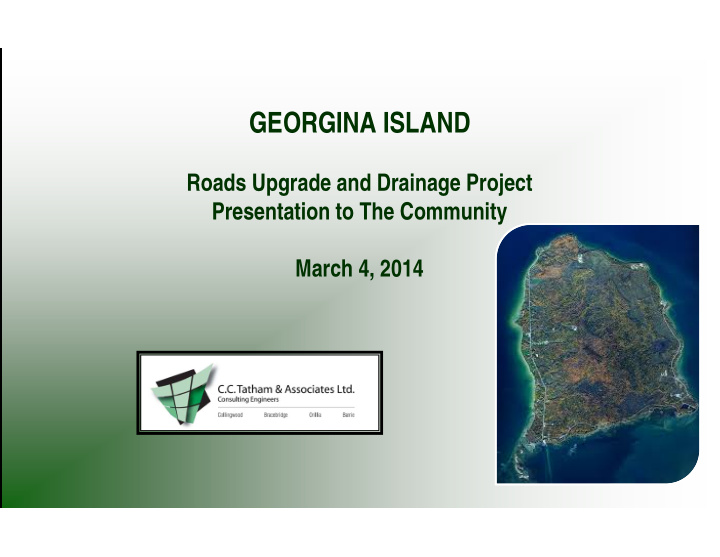



GEORGINA ISLAND Roads Upgrade and Drainage Project Presentation to The Community March 4, 2014
Introduction C.C. Tatham & Associates Ltd. (CCTA) retained by Georgina Island First Nation (GIFN) to provide professional engineering services for upgrading of approximately 10 km of roads; Chief Joseph Snake Road, Loon Road, Bear Road and Root Road; Project includes: Assessment of existing roadway conditions; Recommendations for cost effective reconstruction options; Life cycle analysis; Cost estimates; Drainage improvements; Sidewalk recommendations; LVM Inc. providing geotechnical advice. Introduction 2
Drainage Review Chief Joseph Snake Road, Bear Road and Root Road Existing ditching is poorly defined, shallow and overgrown; Drainage outlets are blocked or missing, restricting flow; Regrading and culvert replacement to provide uniform unobstructed ditches will improve surface drainage; Drainage concerns between Chief Joseph Snake Road, Turtle Road and the lake related to low topography and maintenance needs; Outlet improvement at campground on Bear Road. Drainage Overview 3
Road Overview 4
Loon Road Ditching exists only on southwest side, poorly defined and overgrown; Install a French drain on northeast side to collect road surface runoff, discharging to southwest ditch; Regrade southwest ditch to a uniform positive grade. Road Overview 5
LVM Investigation Thorough evaluation of current roadway conditions: Roadway distresses; Granular base/subbase/surface treatment depths; Road structure materials. Distresses related to: Relatively flat road profiles; Proximity to wetlands; Undefined outlets and high lake levels relative to road ditches and road bases; Existing road structure is shallow, substandard granular material; Concluded existing pavements are well beyond their functional service lives and major rehabilitation is required. Geotechnical Evaluation 6
Rehabilitation Method - Foamed Asphalt Stabilization Place 100 mm granular material over existing pavement (utilizing material quarried on site if available); Pulverize granular material and existing road structure to depth of 225 mm; Stabilize pavement surface with expanded (foamed) asphalt to depth of 150 mm; Double layer surface treatment; Regrade all ditches and replace driveway and road cross culverts. Rehabilitation Options 7
Other Rehabilitation Options and Lifecycle Analysis Full depth excavation; Pulverize asphalt; Mechanical reinforcement. Considers initial capital cost plus 20 years of maintenance; Full depth reconstruction has highest capital cost and 2 nd highest maintenance cost with crack sealing and repaving in year 15; Pulverizing has lowest capital cost and highest maintenance cost with annual spray patching and surface treatment in years 8 and 16; Foamed asphalt stabilization has 2 nd lowest capital cost and lowest maintenance cost with surface treatment in years 10 and 20; Foamed asphalt stabilization is the most cost effective. Rehabilitation Options 8
Construction Cost Estimates Foamed Asphalt Stabilization $ 5,560,000; Includes 10% contingency; Includes all drainage improvements within roadway; Assumes imported granular material, may be reduced by use of on-site quarries; Does not include sidewalk costs; Does not include outlet cleaning/improvements. Cost Estimates 9
Sidewalk 1.5 m widening of south bound lane of road; Low traffic volumes and speeds minimize safety concerns; Delineation of the walkway by line painting; Winter maintenance completed by existing snow removal equipment; Does not alter the established drainage patterns; Does not require work beyond the right-of-way; Estimated construction cost approximately $392,000. Sidewalk 10
Sidewalk 11
Summary Foamed asphalt stabilization with double surface treatment; Most cost effective rehabilitative method to provide adequate structural capacity and meet functional service life expectations; Rehabilitates existing road structure and minimizes placement of new granulars, thereby reducing costs; Double surface treatment for hard surfacing is a cost effective alternative to hot mix asphalt and provides more flexibility during movement of the subgrade due to frost actions and spring thaw; Existing granular quarry material may be suitable for this rehabilitation method and result in further cost savings. Summary 12
Next Steps GIFN confirm preferred solution and construction schedule (2014/2015); Liaison with agencies (MNR, DFO, LSRCA); Survey drainage outlets; Assess quality and quantity of island quarry material; Prepare final design and tender documents; Circulate to invited contractors for tendering; Contract award and construction. Next Steps 13
Before You Leave: Have all of your questions been addressed? For Further Information: Tim Collingwood, B.A.Sc., P.Eng., Ted Kruska, C.E.T., Director, Manager – Orillia Branch Project Manager C.C. Tatham & Associates Ltd. C.C. Tatham & Associates Ltd. t: (705)325-1753 x 224 f: (705)325-7420 t: (705)325-1753 x 225 f: 705)325-7420 e: tcollingwood@cctatham.com e: tkruska@cctatham.com Contact Information 14
Recommend
More recommend